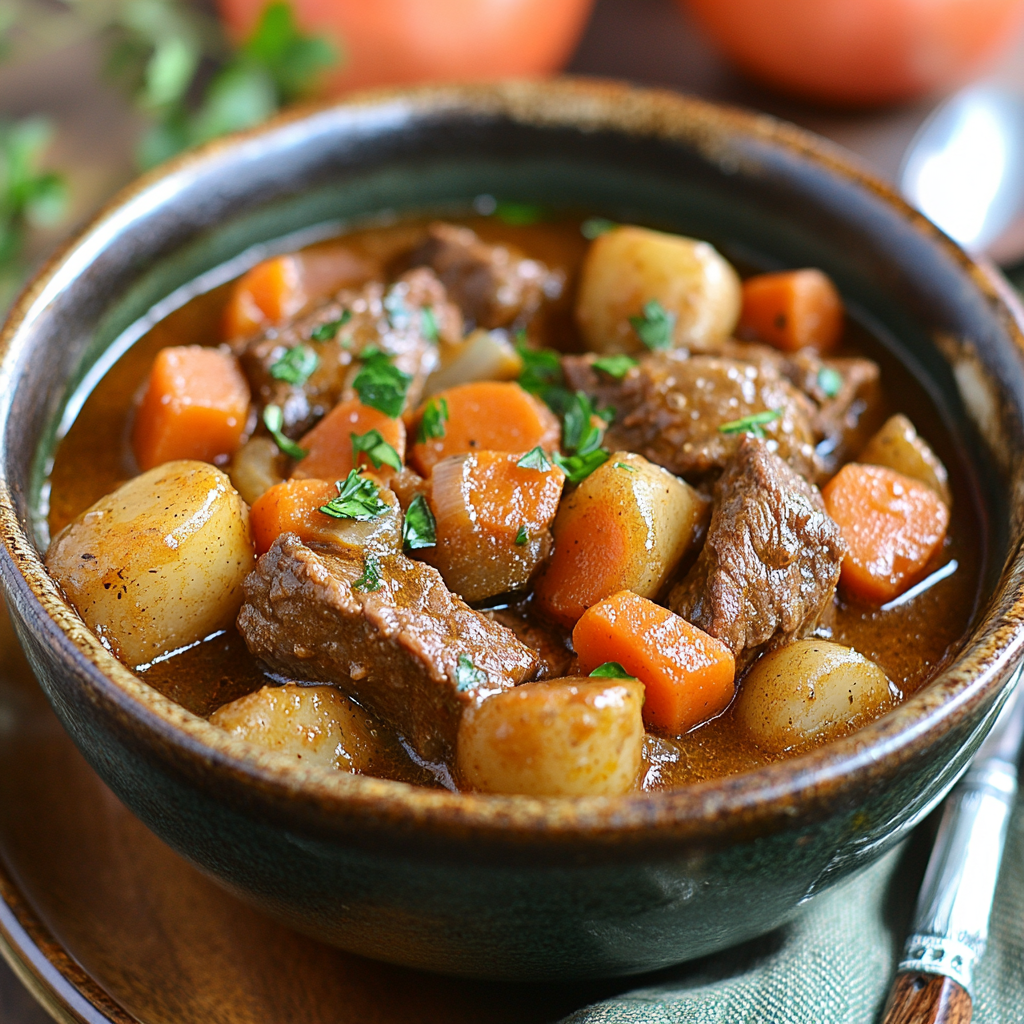Irish beef stew is a classic dish that brings Ireland’s flavors to your home. This traditional Irish recipe mixes tender beef, earthy veggies, and warm herbs. It’s a hearty beef stew great for cozy nights. It’s easy to make, whether you’re new to cooking or have lots of experience.
This stew is rooted in Irish tradition. It uses simple ingredients like potatoes, carrots, and onions. These are slow-cooked with beef to create deep, savory flavors. It’s a Irish comfort food that’s perfect for cold weather. It’s satisfying and easy to make, following this guide.
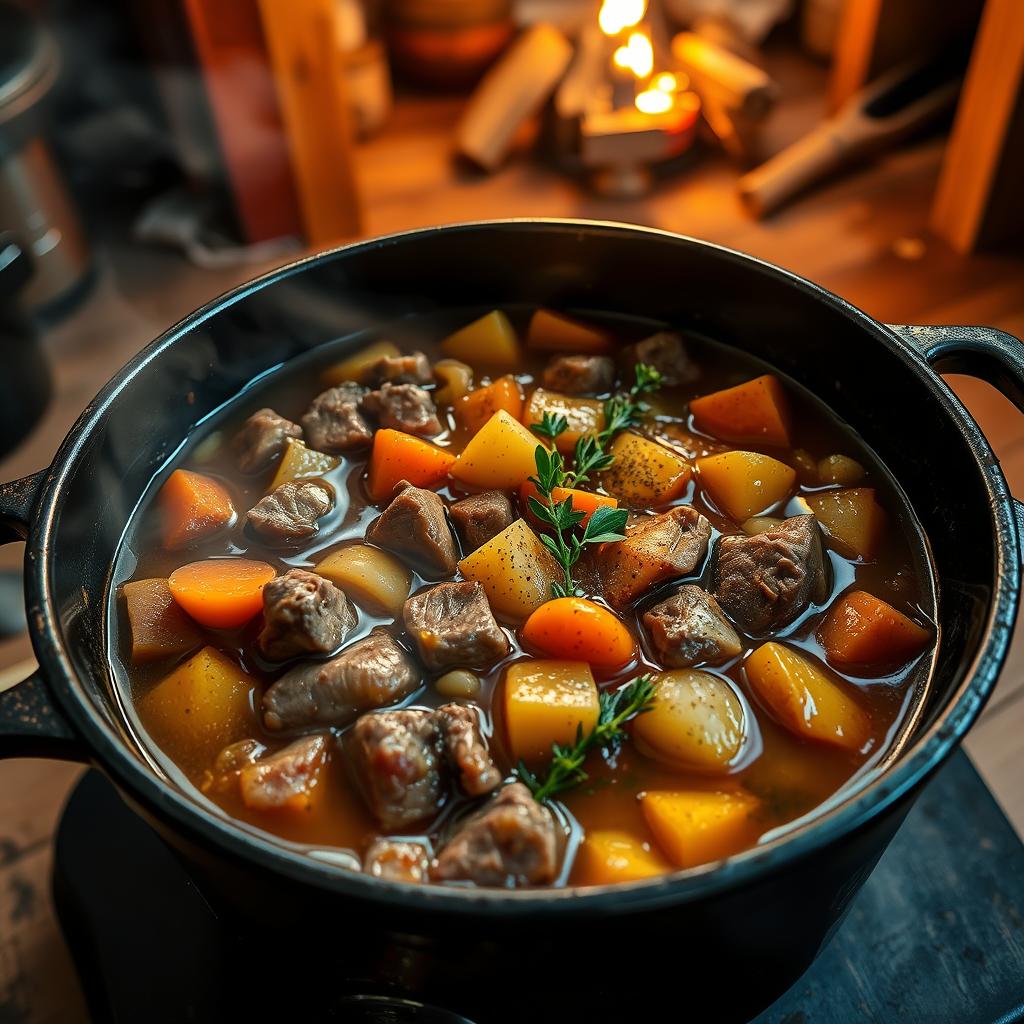
Key Takeaways
- Learn to make Irish beef stew with basic ingredients and minimal steps.
- Discover how this traditional Irish recipe balances bold flavors and simplicity.
- Enjoy a dish that’s both hearty beef stew and a cultural taste of Ireland.
- Perfect for beginners—no professional skills needed to achieve authentic results.
- Pair with classic sides for a complete Irish comfort food experience.
What Makes an Authentic Irish Beef Stew Special
Authentic Irish stew is more than just a meal. It’s a tradition that values simplicity and warm flavors. Unlike other traditional beef stew recipes, its magic comes from simple ingredients. These ingredients are transformed by patience and traditional cooking methods.
At its heart, Irish stew ingredients like cubed beef, potatoes, onions, and curly kale make up this dish. There are no tomatoes or heavy spices to hide its earthy taste.
- Beef: Chuck or round cuts, perfect for slow cooking.
- Root vegetables: Potatoes and onions for a hearty base.
- Seasoning: Salt, pepper, and thyme—no extra herbs needed.
Rustic Irish cooking is all about slow cooking. This lets the flavors blend over hours. The result is beef that’s so tender it falls apart and a broth full of umami.
A common myth is that Guinness is part of the traditional recipe. But, it’s actually a modern twist. Real versions rely on the ingredients’ natural juices and time. This dish’s charm is in its simple roots, passed down through generations as a comfort symbol.
Every spoonful of authentic Irish stew tells a story of Ireland’s culinary soul. It shows that sometimes, less is more.
The Rich History Behind This Beloved Irish Dish
Irish stew’s journey from simple beginnings to a national symbol is filled with resilience and community. Let’s explore how it became a key part of Irish culinary heritage.
Origins in Irish Countryside Cooking
In the 16th century, the history of Irish stew started with peasant families. They used local ingredients like mutton or lamb, onions, and herbs. Potatoes, introduced in the 1500s, soon became a staple, making the dish hearty.
Imagine a farmhouse hearth with a cast-iron pot simmering all day. It brought families together after a long day of work.
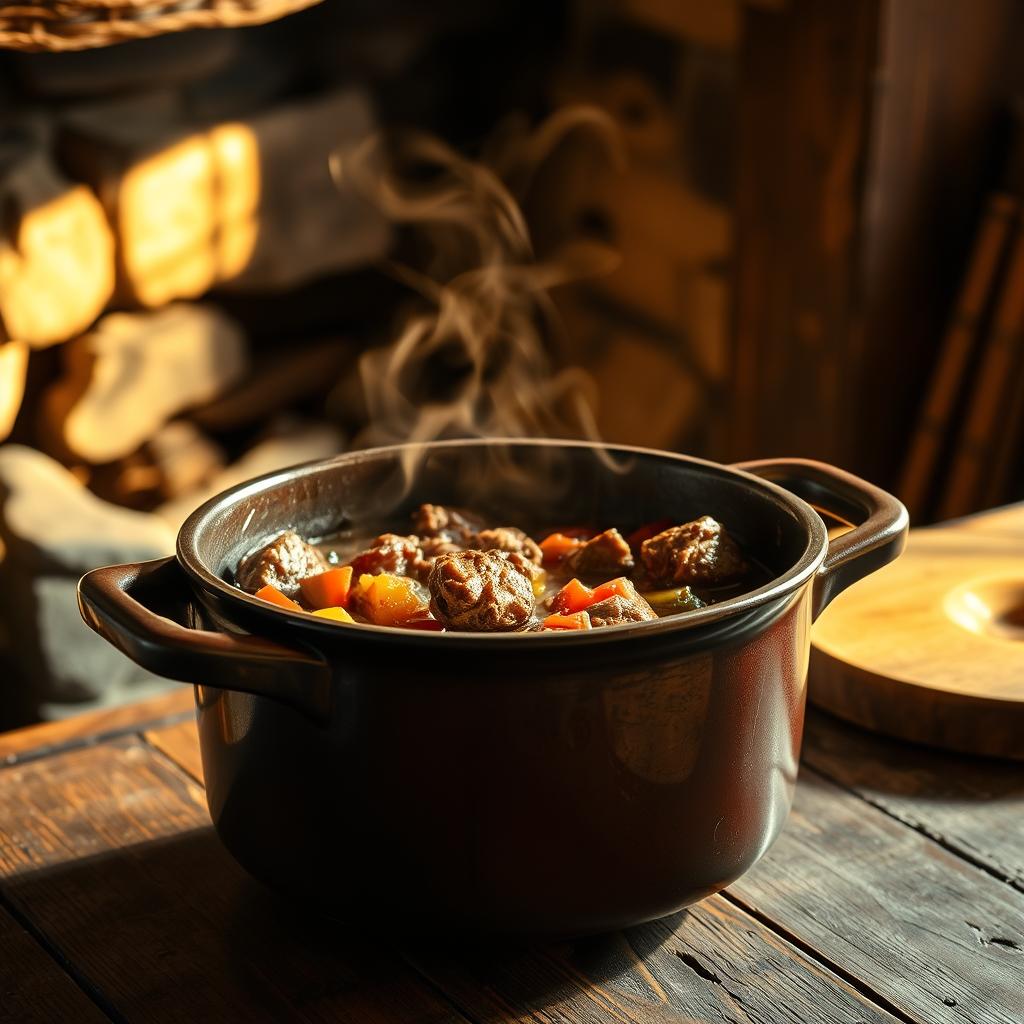
How Irish Beef Stew Evolved Through Generations
Over time, Irish cooking traditions changed. A table shows the main shifts:
| Period | Key Changes |
|---|---|
| 1600s–1800s | Potatoes solidified as a staple |
| 1800s–1900s | Beef replaced mutton as farming expanded |
| Modern Era | Recipes preserved through emigration and tech advances |
Cultural Significance in Irish Celebrations
Today, Irish stew is more than food—it’s a celebration of identity. At St. Patrick’s Day parades or family reunions, its aroma signals warmth and belonging. Sharing a pot of stew embodies Ireland’s legendary hospitality, linking past and present through every spoonful.
Essential Ingredients That Create the Magic
Every spoonful of authentic Irish beef stew relies on a blend of timeless components. Here’s what makes the difference:
- Beef for Irish stew: Chuck roast is the star—its marbling melts into tenderness during slow cooking. Avoid lean cuts like sirloin, which can dry out.
- Traditional stew vegetables: Potatoes, carrots, and onions form the backbone. Peel onions thinly to caramelize, and cube potatoes evenly for even browning.
- Irish stew seasonings: Bay leaves and fresh thyme are non-negotiable. A pinch of black pepper adds warmth without overshadowing the meat.
| Ingredient | Role |
|---|---|
| Chuck roast | Delivers rich flavor and fork-tender texture |
| Worcestershire sauce | Enhances umami depth in broth |
| Carrots | Add natural sweetness that balances savory elements |
“The best Irish stew uses ingredients that sing together, not solo.” — Traditional Irish culinary proverb
For American shoppers, look for Irish stew ingredients at local butchers or major chains like Whole Foods. Substitute pearl onions for shallots if unavailable. A 3:1 potato-to-carrot ratio ensures classic proportions.
Optional additions like Guinness or leeks can elevate dishes, but stick to core elements first. Always pat beef dry before searing to achieve golden browning—the base of deep flavor.
Step-by-Step Irish Beef Stew Recipe
Learn to make the perfect Irish stew recipe with this easy guide. This homemade Irish stew takes about 2.5-3 hours. It’s a mix of tradition and technique for a dish that’s both comforting and flavorful. Follow these steps to make the real deal.
Preparing Your Ingredients
- Cut beef into 1.5-inch cubes for even cooking.
- Dice onions, carrots, and potatoes to similar sizes as the meat.
- Pat beef dry with paper towels to ensure proper searing.
- Organize all ingredients using mise en place to streamline the process.
Searing the Beef to Perfection
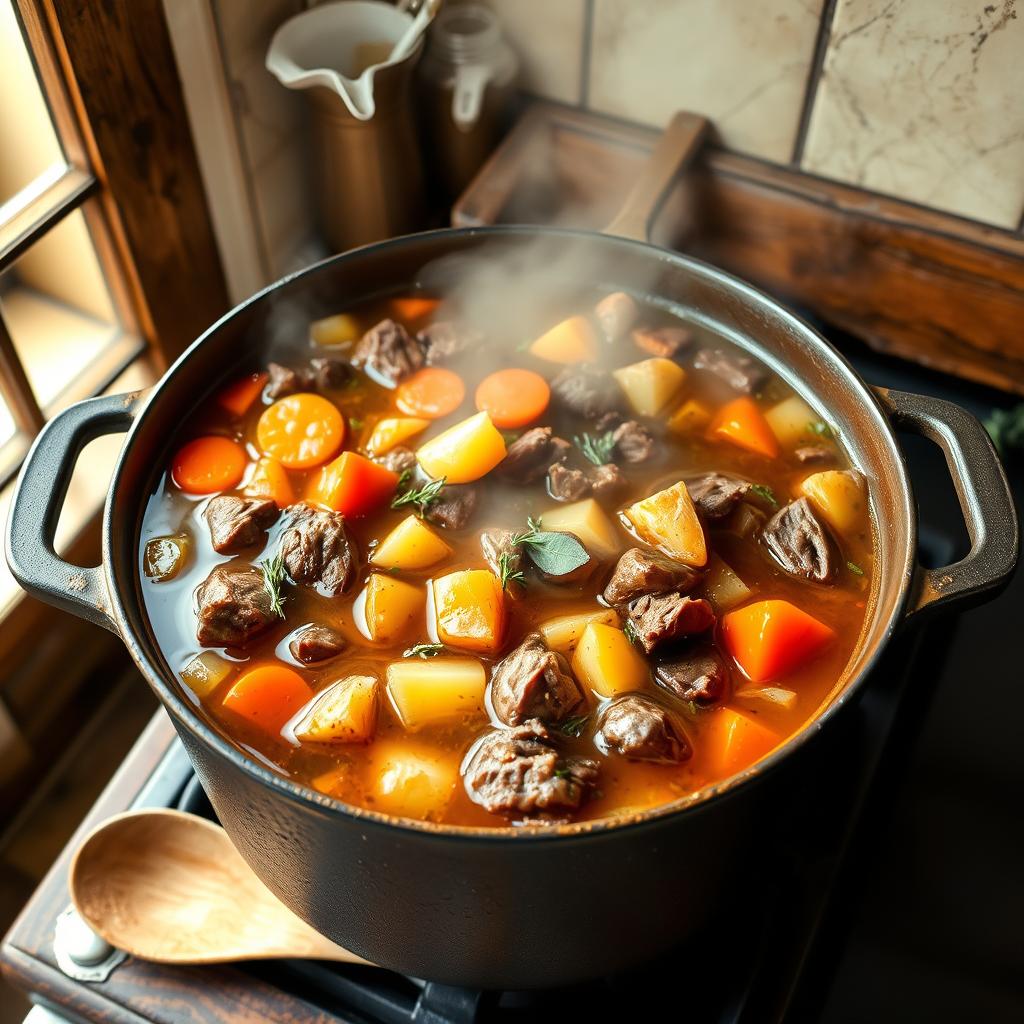
Heat a heavy pan over medium-high. Sear beef in small batches, avoiding overcrowding. Listen for a sizzle and watch for a golden crust—this Maillard reaction creates rich flavor. Transfer seared meat to a bowl and repeat with remaining pieces.
Adding Vegetables and Liquid
- Reduce heat, sauté onions and garlic until fragrant.
- Deglaze the pan with broth, scraping up browned bits.
- Add seared beef, vegetables, and liquid (stock or beer). Guinness adds depth!).
- Simmer briefly to meld flavors before slow cooking.
Slow Cooking Method for Ultimate Tenderness
| Method | Time | Heat | Benefits |
|---|---|---|---|
| Stovetop | 2-2.5 hours | Simmer | Hands-on control |
| Oven | 2 hours at 325°F | Even heat | Set-it-and-forget-it convenience |
Finishing Touches for Maximum Flavor
Before serving, adjust salt and pepper. For a thicker stew, mix in a flour slurry or cornstarch. Stir in fresh thyme or parsley just before serving. Taste and tweak seasoning—this is your Irish beef stew, so make it yours!
Pro Tips for a Mouthwatering Result
Mastering the perfect Irish stew starts with these simple Irish stew tips. Even seasoned cooks can refine their approach with these expert strategies:
- Choose beef with visible marbling for natural moisture. Opt for chuck or round cuts for tender results.
- Brown beef in batches to avoid steaming. Overcrowding leads to gray meat—this is a core beef stew techniques rule.
- Scrape the fond (browned bits) into the broth. This stew cooking secrets step adds deep, savory layers of flavor.
- Simmer, don’t boil. A gentle bubble keeps meat fall-apart tender.
Make it better by refrigerating overnight. The flavors meld overnight, making leftovers taste even richer. Let the stew rest 10 minutes before serving to enhance texture.
| Issue | Fix It |
|---|---|
| Meat still tough? | Simmer longer, up to 3 hours |
| Broth too thin? | Stir in a roux or cornstarch slurry |
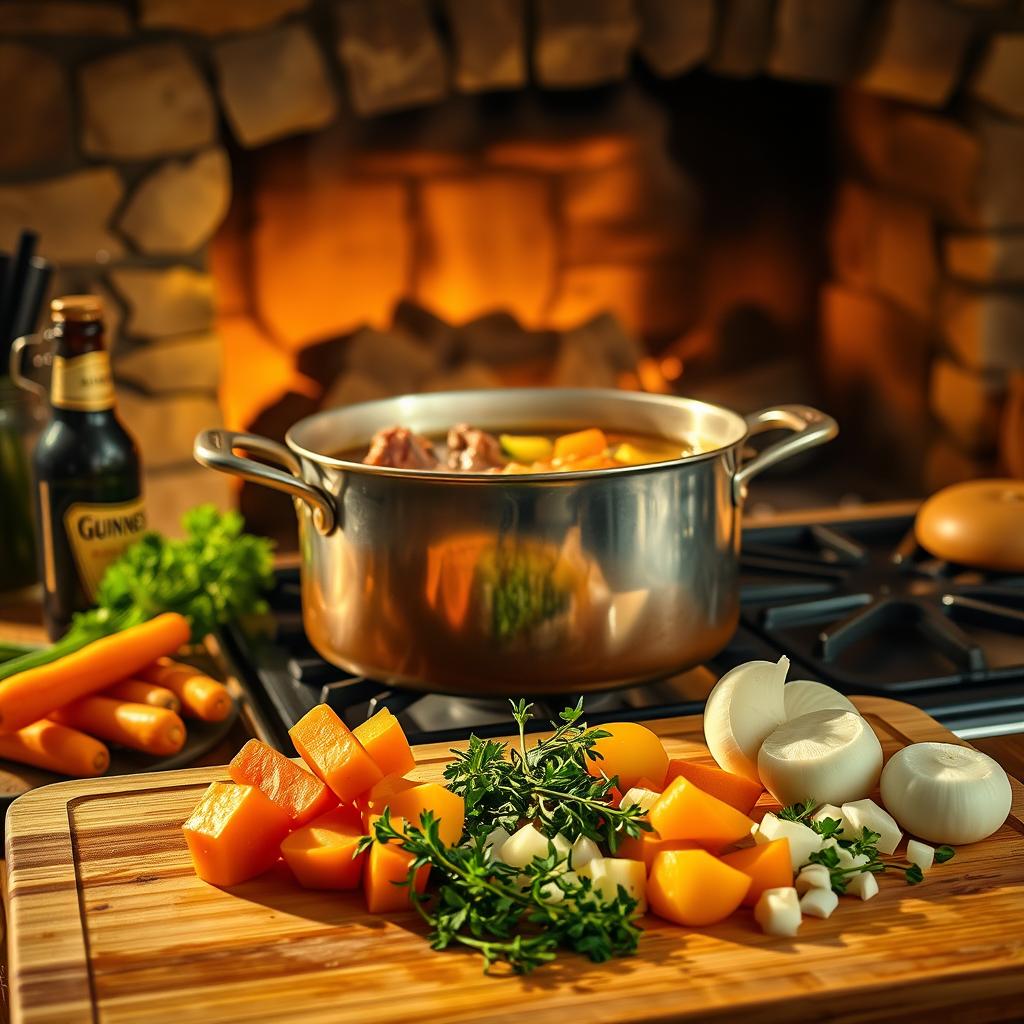
Experiment with these tricks to achieve the perfect Irish stew. Every bite should reflect tradition and technique!
Delicious Variations to Try
Ready to try something new? These Irish stew variations keep the tradition alive with a twist. Whether you love bold flavors, seasonal veggies, or herbs, there’s a version for you.
Guinness Beef Stew
Try Guinness beef stew for a rich taste. The stout adds a deep, maltier flavor. Use 1 cup during simmering.
It balances with savory beef. For a hint of sweetness, add a dash of molasses. This modern twist is loved in Dublin pubs.
Vegetable Irish Stew
Do you love veggies? Try a vegetable Irish stew with parsnips, turnips, and rutabaga. Cut all into 1-inch cubes for even cooking.
Celery root adds earthy crunch, while carrots soften the mix. It’s perfect for meatless meals or veggie fans.
Herb-Enhanced Irish Stew
Enhance aroma with an herb-enhanced Irish stew. Start with thyme and bay leaves early for a slow infusion. Add fresh rosemary and parsley in the last 10 minutes.
Use a herb bouquet garni (tied herbs in cheesecloth) for easy removal. Dried herbs? Use half the quantity of fresh for intensity.
Perfect Pairings: What to Serve Alongside
Choosing the right sides and drinks for Irish stew is key. It’s about honoring tradition while making your meal special. Let’s look at the best sides and drinks to make every bite memorable.
Irish soda bread is a must-have for sopping up stew. This Irish soda bread recipe is easy, needing just flour, buttermilk, and baking soda. If you don’t have buttermilk, vinegar and milk mix works great. In Ireland, caraway seeds are traditional, but raisins are more common in the US. Serve it warm, split, and buttered, to enjoy every bit of broth.
Choose drinks that match the meal’s spirit. Guinness complements the stew’s richness, while Jameson Irish Whiskey adds a celebratory flair. For those who don’t drink, Barry’s Tea with milk or Woodchuck Hard Cider are great options.
Planning a full menu? Begin with light starters like smoked salmon on rye or a parsnip soup. For Irish stew sides, try colcannon (mashed potatoes with cabbage) or buttered carrots. Finish with apple cake or bread pudding with whiskey sauce. Make soda bread and desserts the day before to ease dinner prep.
- Soda bread: No yeast needed—mix, bake, and enjoy in under an hour.
- Drinks: Match bold flavors or opt for family-friendly options.
- Full menus: Mix traditional and modern dishes for any gathering.
These Irish meal pairings transform a simple stew into a feast. Each part, from the soda bread to the perfect drink, comes together beautifully.
Storing and Reheating Your Stew
Even the best leftover Irish stew can shine with proper care. Let flavors deepen by refrigerating your stew within two hours of cooking. Follow these stew storage tips to keep it fresh:
When freezing Irish stew, divide into airtight containers with 1-inch headspace. Thaw frozen batches overnight in the fridge before reheating. For reheating beef stew, try these methods:
- Stovetop: Simmer covered on low heat, adding broth if needed.
- Microwave: Heat in 2-minute bursts, stirring between cycles.
- Oven: Bake at 325°F for 20–25 minutes covered.
Revive leftovers with fresh thyme or a dash of Worcestershire sauce. Get creative with these ideas:
- Top mashed potatoes with a hearty spoonful.
- Layer into a shepherd’s pie with mashed potato topping.
- Use as filling for a crustless quiche or rustic pot pie.
Conclusion: Bringing Irish Comfort to Your Table
Every pot of Irish beef stew is more than a meal—it’s a link to centuries of Irish culinary heritage. By following this recipe, you’re joining a tradition. Simple ingredients like potatoes, carrots, and slow-cooked beef become a source of warmth and connection. Whether you’re celebrating St. Patrick’s Day or just craving hearty comfort, this dish invites you to embrace Irish cooking traditions in your own kitchen.
Sharing this stew with loved ones mirrors how families in Ireland have gathered around such dishes for generations. The act of making homemade Irish food turns your kitchen into a bridge between past and present. Experiment with variations like Guinness-infused stews or herb-enhanced flavors to explore authentic Irish recipes further. Each tweak keeps the spirit of Irish cooking alive, proving that cultural dishes thrive when adapted with care.
Food has a way of making heritage tangible, and this stew embodies that perfectly. Its humble origins in Irish countryside kitchens remind us that the best meals are those that bring people together. So serve it with pride, knowing every bite honors tradition while creating new memories. Whether you’re tracing your roots or simply seeking cozy flavors, this recipe is more than a dish—it’s a story waiting to be shared, one pot at a time.
FAQ
What cut of beef is best for Irish beef stew?
Chuck or round are the top choices for Irish beef stew. They’re full of flavor and get tender when cooked slowly. This makes them ideal for this hearty dish.
Can I use vegetables other than potatoes and carrots?
Yes! You can add other root veggies like parsnips or turnips. They bring extra flavor and texture to the stew.
Is Guinness a traditional ingredient in Irish beef stew?
Guinness is a modern addition to Irish beef stew. Traditional recipes stick to simple ingredients without beer.
How can I make my stew thicker?
Mix flour and water to thicken your stew. Or, let it simmer uncovered to reduce the liquid. Adding mashed potatoes near the end also helps.
What is the best way to store leftover Irish beef stew?
Store leftover stew in airtight containers. It keeps in the fridge for 3-4 days or in the freezer for 3 months. Cool it completely before freezing!
Can I freeze Irish beef stew?
Yes! Irish beef stew freezes well. Cool it completely before freezing in airtight containers, leaving space for expansion.
What’s a good way to reheat leftover stew?
Reheat on the stovetop, in the microwave, or in the oven. Stir often to heat evenly.
How does Irish beef stew differ from other beef stews?
Irish beef stew is simple yet flavorful. It uses quality beef, fresh veggies, and traditional seasonings. This creates a rich, hearty broth.

